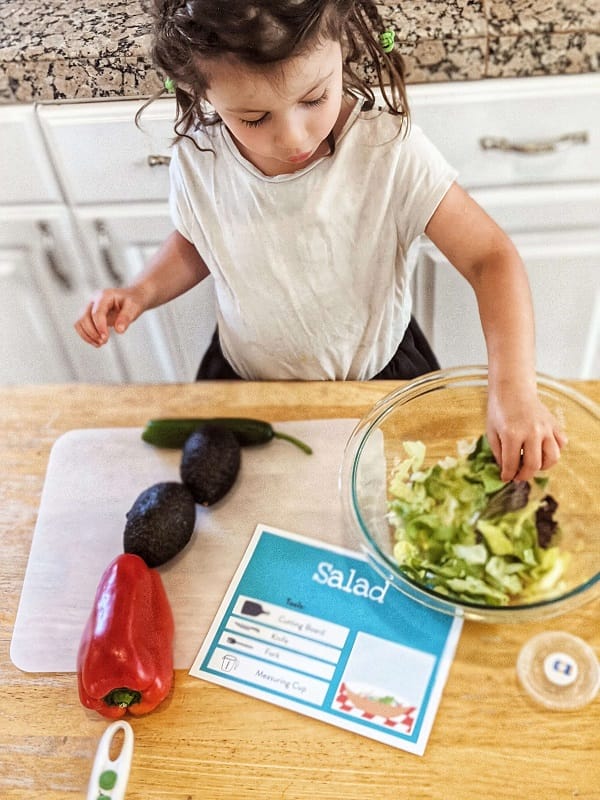Title of the List (Benefit, # of times, time frame)
Feeding kids is hard! It feels like the foods that they want to eat aren’t the ones we want them to eat, and vice versa. Or they’re never hungry at mealtimes, but seem to want a snack the minute they get into the car. Yes, it’s hard, but there are three key things to understand when it comes to feeding kids.
1. Parents' Actually Responsibility for Feeding Kids
As parents, we have many jobs. We are often our children’s: chef, chauffeur, cleaning person, tutor, playmate, scheduler, personal shopper, social activity coordinator and of course, role model. Parents spend a lot of time worrying about their kids and wondering how they’re every going to become responsible for themselves. Especially when it comes to eating. We have a hard time understanding the division of responsibility at mealtime.
The good news is that when it comes to mealtime responsibility, the experts have done the hard work for us. They’ve figured out what we as parents need to do and what kids should do for themselves. Brace yourselves because the answer may come as a shock.

Division of Responsibility
First, let me introduce the expert. Her name is Ellyn Satter and she really is one of the best sources for information on how to feed kids. She’s a social worker and dietitian, so she really gets the intersection of raising kids and feeding them. She’s also written a bunch of wonderful books, like The Secrets of Feeding a Healthy Family. Spoiler Alert: There is no secret! But she does offer a lot of great advice and tips, all based on actual research.
One of her famous ideas is the division of responsibility at mealtime. It’s pretty straight-forward and completely groundbreaking at the same time.

Parents' Responsibility: What & When
Parents are in charge of deciding what is being served and when. This is something that is actually easier to leave up to the kids, especially if they are similar to the loud, insistent children I have in my home. Kids who demand snacks, complain about being hungry or reject dinner in favor of a peanut butter sandwich are encroaching on our job.
It is the parent’s job to decide WHAT we eat and WHEN we eat. Of course, you can make things easier by serving meals and snacks at regular intervals and offering at least 1 choice that your child will eat. The idea is to have children who are well-fed, come to the table ready to eat and learn how to eat the foods that the family already enjoys. Allowing children to decide the WHEN and the WHAT of mealtimes actually makes it harder for them to learn how to become healthy eaters.
So what do you do if a child insists on eating snack right before dinner? Well, snack time falls under the role of the parent. So you either move snack time so kids aren’t starving or move dinner time to a time that the kids are already hungry. As long as you are consistent and patient (which I’m beginning to think is the actual secret to ever accomplishing anything) your children will trust that you will feed them and they will learn to eat at mealtimes.
And what about the kid who won’t eat anything other than cereal for breakfast, lunch and dinner? Again, the WHAT of meals is the parent’s job. So if you are serving spaghetti and meatballs that is what’s for dinner. The end. If your child doesn’t want it, then they can have food at the next meal. Again, consistency and patience are key, but insisting that children eat the food that you offer them is one of the best ways to help them become healthy eaters.

Child's Responsibility: Whether & How Much
So now you can relax! You served a healthy meal at a regular time. Your job is done. Now it’s the kids’ turn to decide whether or not they’re going to eat. They might decide not to eat. Which is fine, since that falls under their responsibility. They just need to understand that if they’re choosing not to eat, then there is no more food until the next meal or snack. WHEN is the parent’s job. So eat now or hold your peace until breakfast.
Kids are also responsible to decide HOW MUCH they eat. It’s a common mistake that parents urge their children to eat more, or eat less of various foods. The idea is that kids will learn how to self-regulate. If we try to control how much they eat, then they won’t learn how to self-regulate. We want them to eat they right amount without us telling them to do so. So here’s your permission to let them eat as much or as little as they want. As long as you’re serving healthy choices at regular intervals, you can stop worrying about the amount they’re eating.
So, How Does This Actually Work?
This division of mealtime responsibility is difficult to implement. Many people didn’t grow up with this model, so they aren’t familiar with it. It sounds counter-intuitive to what parents think their role is. We think it’s our job to make sure our kids eat well and grow. So we will feed them whatever and whenever they want. But we’ll also insist that they have a few bites of salad if they want dessert.
In reality, our job is hard. Create a reliable schedule and stick to it. Don’t give in to complaints. Serve food for everyone and don’t cater to individuals, even if they cry and scream and tell you that you’re the worst parent ever. We also have to let our kids do their job of deciding how much they eat. Ellyn Satter says it best: “If parents do their jobs with feeding, then children will do their jobs with eating.”

2. The Right Parenting Style When Feeding Kids
When it comes to parenting, there are 4 basic styles. These are based on the work of developmental psychologist Diana Baumrind. Each style is a measurement of how responsive and how demanding parents are. Parents who are highly demanding and not very responsive are Authoritarian. Parents who are highly responsive and not very demanding are Permissive. Parents who are neither demanding nor responsive are Negligent. And parents who are both demanding and responsive are Authoritative.
Parenting Styles at the Table
-
Authoritarian Parent – These are the parents who rule with an iron first. At the table, these parents are the ones telling their children how much they need to eat. They may punish a child who doesn’t obey, for example by withholding dessert or by not allowing the child to leave until he’s cleared his plate.
-
Permissive Parent – These parents don’t set strong boundaries for their children. At the table, these parents let their kids eat whatever they want. There are no rules enforced about when or where meals take place. These parents may also allow TV or screens at the table, unlimited access to junk food and little guidance on how to eat well.
-
Authoritative Parent – These are the parents who create rules and explain them to their children. They are open to a discussion, but ultimately have the final say in decision-making. At the table, these parents provide healthy options, but don’t force children to eat. They explain clearly when and what is being served, but aren’t easily swayed by a screaming child.
-
Negligent Parent – This is what is sounds like – parents who don’t provide what their kids need. It’s a very serious situation and way beyond the scope of this blog.

Is there REALLY a Best?
Well, of course there’s a debate. There’s a debate over how culture affects parenting. There’s a debate over how much impact parents even have. For the most part, studies show that children raising with authoritative parents have the most successful outcomes.
Not surprisingly, parenting styles also play a role at the table. Because Authoritative parents are highly responsive to their kids and also highly demanding, there’s a little bit of leeway here.
For example. your child had a hard day at school and requests pizza for dinner. It’s ok to be more responsive than demanding and order a pizza. If your child spent the afternoon at a friend’s birthday party, then it’s also ok to be more demanding and insist that they either eat the healthy dinner you’re serving or not eat at all.
The important thing is to find the balance. Offer your child healthy food, served regularly and also know when to relax the rules a little. Pay attention to any mistakes you may make.
Remember how we act is just as important as what we say. If you follow the division of responsibility for feeding, then chances are good that you’re creating a table of good role modeling, healthy choices and lots of respect.

3. How to Successfully Offer Food Choice
It’s pretty clear to parents of young children that offering choice is important. It helps create a sense of autonomy, supports their budding independence and also may reduce the amount of crying and screaming at any given moment. It’s a great to allow a child who doesn’t want to get dressed the choice of which shirt to wear. What about at the table? How and when should we allow our kids to make a food choice?
Choice - What it DOESN'T Mean
Sometimes, when we hear the word “choice” we automatically think of “freedom.” Here is what offering choice isn’t: Freedom to Decide What’s for Dinner. Remember, the WHAT of meals falls to the grown-ups. It’s not helpful to your child, (or to you really) to have them make this decision. Children should not get to pre-approve a menu. They should not raid the pantry because they can eat anything they want. Input is fine, and always welcome. Adults still, (and always) get the final say.

5 Tips for Offering Food Choice to Kids
- Start Small – You don’t need to have an extensive menu in order to have choice. There is such a thing as decision fatigue. For most people about 3-5 items is enough of a choice. For young kids, about 2-3 choices is enough to give them a sense of autonomy without overwhelming them.
- Pre-Approve all Choices – Make sure that you’re ok with your kid eating any and all of the foods you are offering. Don’t want them eating a bowl of cereal for dinner? Then don’t offer that as a choice. Choices should be limited to what you feel comfortable with. This also applies to the amount of work for you. You kid wants pasta with homemade sauce, fresh basil and parmesan sprinkled on top? Only if you’re ok with making it.
- Offer something they might not love – Exposure is the best way to expand a picky eater’s palate. So if your child doesn’t like carrots, should you offer them as a choice? Does that even count? YES! Offer carrots, even if you think they might say no. They just might surprise you.
- Offer something you know they love – If your kid loves spaghetti, but doesn’t love green beans, then serve them together. This helps increase exposure to the green beans, but makes it less scary. At least there’s also some comforting spaghetti on the table. This also helps you relax as a parent, since you know that there’s at least 1 thing your child will eat.
- Take “No” for an answer – Make sure that not eating is a choice too. It doesn’t always work, for example, you kid does need to pick at least 1 shirt to wear to school. For meals though, nothing is always a choice. It should be respected just as much as any other choice. If your child decides not to eat, then leave it at that.
Conclusion
Yes, feeding kids is hard, but it’s also one of our most important responsibilities as parents. There are a few things you can do to help your child learn to feed themselves, without resorting to bribery, punishment or force feeding.
One of the best ways to feel good about what your kids are eating is by getting them involved in cooking. That and keeping our dinner tables a place for connecting with the people we love.




